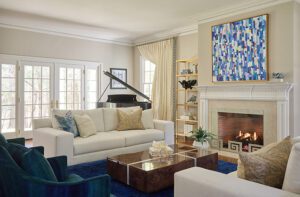Painting with Wood
March 6, 2012
In his tool-scattered, wood-flour-coated, Billie Holiday–blasting workshop, Silas Kopf is building amazing paintings with wood.
Text by Nathaniel Reade
In his tool-scattered, wood-flour-coated, Billie Holiday–blasting workshop, Silas Kopf is building a cabinet with trick drawers and secret compartments. It’s made of mahogany and narra, with graceful, curving legs. The piece is impressive, but it’s the doors that make you do a double take: they’re closed, but it looks like one is slightly open to reveal a glimpse of people inside the cabinet using various twenty-first-century gadgets such as laptops and cell phones. This bit of trompe l’oeil isn’t painted; it’s made entirely from thin pieces of wood.
Kopf is a tall, rangy, smiling man with white hair and a penchant for vintage Hawaiian shirts (he says he got tired of seeing woodworkers in plaid flannel). Now sixty-two, he grew up in a small town in western Pennsylvania. He earned an architecture degree from Princeton University but found himself drawn to sculpting wood instead of designing buildings. During a two-year stint working with Wendell Castle, a legend of the American craft-furniture movement, he began learning about great European furniture makers such as Émile Gallé and Émile-Jacques Ruhlmann, who made extensive and beautiful use of marquetry.
His goal for his own work, Kopf says, was to “take that eighteenth-century technique and make it modern.” He has succeeded. A curator at the Victoria and Albert Museum in London recently called him “easily America’s most adept practitioner of marquetry.”
Marquetry often gets confused with inlay, which involves cutting into a solid piece of wood and filling it with another piece, then planing it flush. Marquetry requires piecing together veneers into a sheet, like a jigsaw puzzle, and gluing the sheet to wood. Some people make marquetry pictures to hang on the wall; Kopf prefers combining this two-dimensional art with the three dimensions of furniture. He blends the two together, as with a small cabinet he calls Sloppy Paint Job. The top depicts a veneer brush and veneer swatches of paint that look like they’re dripping down the sides.
For another cabinet, Kopf is creating a garden panel. First he draws the flowers from life, using a pencil on a sketch pad. He outlines the perimeter of each tone on the drawing, making little islands out of the blacks, grays and whites. With carbon paper, he transfers the outlines onto thin sheets of maple, starting with the center of a leaf, using the grain of the wood to simulate the leaf’s veins. Next he lays the maple over a sheet of black walnut, which will be the leaf’s stem. He tapes them together and turns on his foot-pedal-operated scroll saw, which has a blade as thin as a thread. He carefully and quickly cuts the line between the two veneers, ensuring that they’ll match perfectly. He lays these two pieces over another veneer—holly, nearly white, which will form a tiny highlight along the top of the leaf. He keeps overlapping, taping, cutting, adding on to the image. To create the effect of shadow, he darkens part of the leaf with hot sand he keeps in a skillet on a nearby hot plate.
Over the course of a week and hundreds of pieces, some as small as a rice grain, Kopf builds an entire panel of wood. He then glues this to a sheet of furniture-grade plywood and puts it in a press. When the glue dries he scrapes and sands the piece to reveal an image with all the depth, shading, form and emotion of a painting.
The marquetry process requires such patience and skill that it can make conventional furniture, no matter how well made, seem simple, almost lazy. And Kopf’s work is more than just technically skillful; his images can be startling, funny or so awe-inspiringly gorgeous that spectators have to walk around them for a while, their mouths open. His work makes one wonder: why isn’t he world famous? Where’s his MacArthur “genius” grant?
Kopf would probably have the name recognition he deserves if he worked in Europe, not Easthampton, Massachusetts. America doesn’t have Italy or France’s history of marquetry furniture craftsmanship. Our early furniture makers came out of the English tradition, such as Chippendale and Adam, which featured carved designs instead. Yet “if you look back historically,” Kopf says, “the best furniture was done with veneers.”
Thanks to him, it still is.
Editor’s Note Silas Kopf is represented by Gallery Henoch, New York City, (917) 305-0003. To see more of his work, visit www.silaskopf.com.
Share
![NEH-Logo_Black[1] NEH-Logo_Black[1]](https://www.nehomemag.com/wp-content/uploads/2022/08/NEH-Logo_Black1-300x162.jpg)














You must be logged in to post a comment.